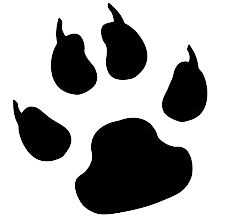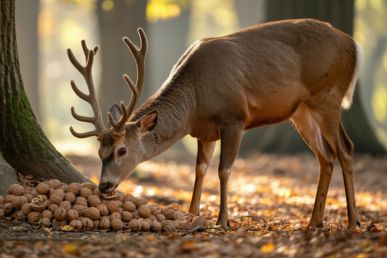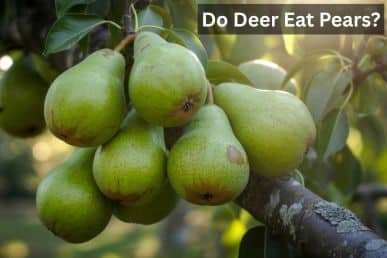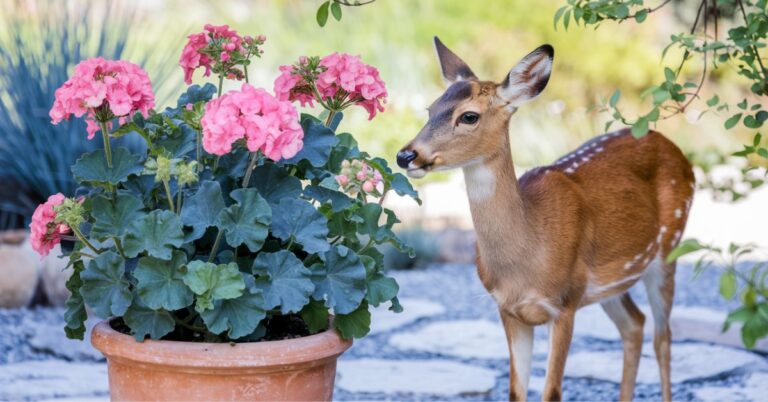Do deer eat grapes? Shocking Truth and How to Stop Them
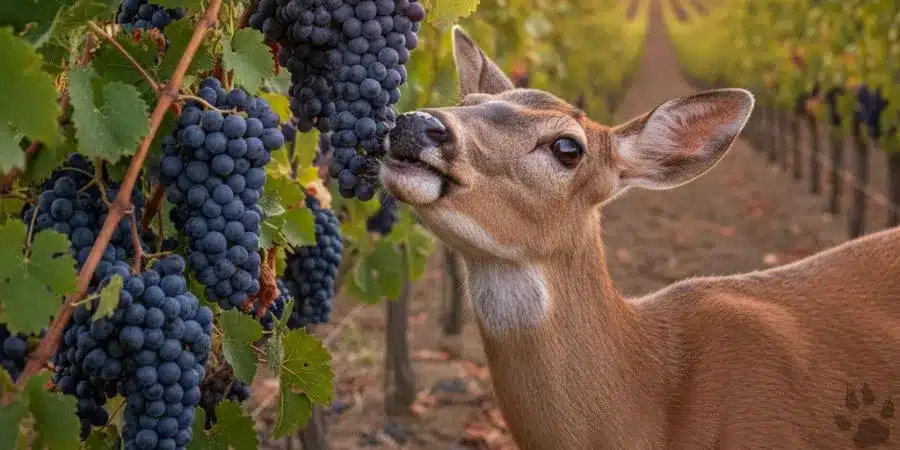
Have you ever stepped into your garden, excited to check on your grapevines, only to find them chewed up, trampled, or mysteriously bare overnight?
If you live in an area where deer roam freely, you’re not the only one asking, “Do deer eat grapes—and more importantly, how can I stop them?” The short answer: Yes, deer love grapes—and they’re not shy about eating the vines too.
In this article, we’ll explore why deer are drawn to grapevines, what kind of damage they can cause, and, most importantly, how to protect your precious plants using a variety of proven methods.
If you want to enjoy your grapes without worrying about surprise visitors, this guide will help you deer-proof your garden the smart way.
What time of year do deer eat grapes the most?
Deer are most likely to eat grapes during the late summer through fall, which is the time when grapes start to ripen. This ripening stage is called “veraison”, and it’s when the grapes become softer and sweeter—something deer find especially appealing.
In most parts of the U.S., this peak grape-eating season for deer happens between August and October. In cooler areas or when growing a late-ripening grape variety, deer may continue feeding into November.
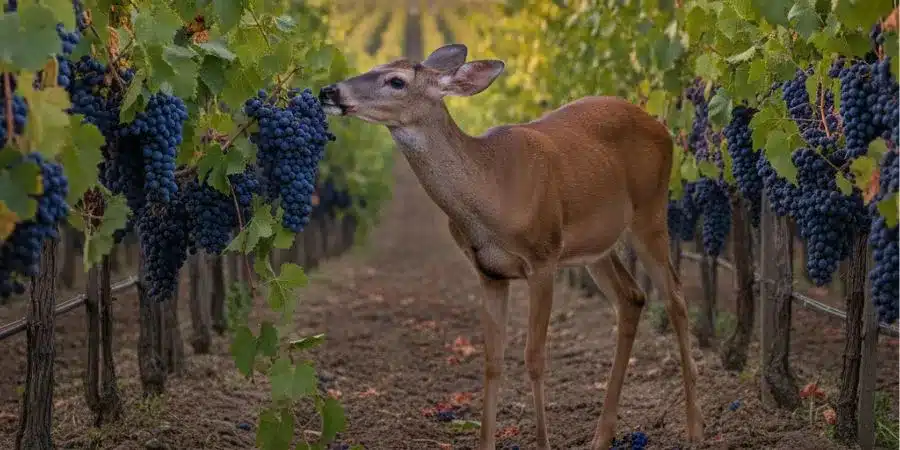
Do deer eat grapes or grape vines?
As I told you above, deer like to eat grapevines, including grapes. There are two situations when this deer behavior becomes a problem, which are as follows:
- When grapevines are young and working hard to grow, young plants are softer and easier for deer to chew.
- And when the grapes are ripe, that’s when they attract deer because they’re attractive and sweet.
Interestingly, deer may also be drawn to dried grapes like raisins due to their sweetness. Curious how safe raisins are for deer? Find out here.
Why do deer love grape vines, and when should you be most cautious?
Deer’s love of grapes causes many problems for growers, especially when the vines are young and in their developmental stages, or when the grapes are ripe and the growers are thinking about harvesting them.
As you have been told before, deer enjoy eating young, tender plant shoots more, but they are also more attracted to plants that have been freshly fertilized because fresh fertilizer enhances the new growth and attractiveness of the plants.
If you live in an area where deer are present, you will need to take proactive steps to manage them. Some effective steps are listed below in this article.
How do you know if a deer has attacked your grapes?
It is not very difficult to find out whether a deer has come to your garden or not.
First of all, if you see deer hoof prints (about 2 to 3 inches in length), deer droppings (0.25 to 0.5 inches long), some crushed grapes, broken branches, or some plants that the deer have stepped on, then this is one of the biggest signs that a deer has come to your garden.
If the hoof prints in your garden are pointed at the front and rounded at the back, they may belong to a deer. If your grape vines have been eaten from a height of about 5 to 6 feet, this is also clear evidence of a deer visit.
Do deer-resistant grape varieties exist?
Unfortunately, there are no types of grapes that are truly “deer-resistant.” No matter what kind of grape you grow—whether it’s vinifera (like wine grapes), labrusca (like Concord), hybrids, or muscadine—deer will still eat them.
They don’t really have a preference—they’ll eat both the vines and the fruit of any grape variety. So if deer are common in your area, the only method that works reliably is to use a properly built fence to keep the deer out.
Even if you use other methods like repellents or scare devices, they should be seen as extra protection, not your main strategy.
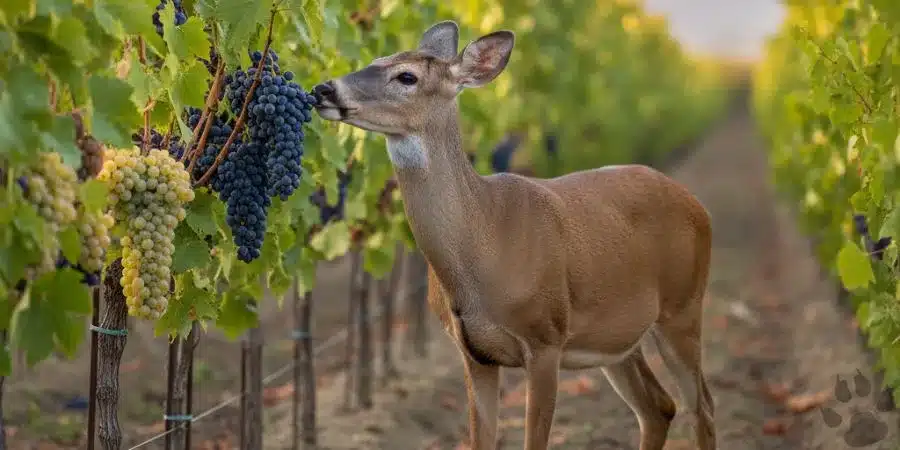
The most common ways to deter deer from your vineyard
Install an electric fence
Unlike some traditional fences that make the land ugly, electric fencing can be effective against deer and is used by many grape growers.
Electric fences are usually cheaper to set up than heavy-duty fences like woven mesh fences, but they can cost more over time because they need regular maintenance to keep working properly.
The best kind of wire to use in electric fences is called high-tensile wire. This type of wire is strong and flexible, so it doesn’t break or stretch easily if:
- A deer runs into it
- A tree branch falls on it
- Farm machinery bumps into it
However, when using an electric fence, you should not have in mind harming the deer, but rather you should use it only so that the deer learns to stay away from it when it is shocked by the electric fence for the first time.
Here’s how to do that:
- After setting up the electric fence, place food that deer like near it.
- One of the best ways to attract deer to an electric fence is to use peanut butter, which deer find very attractive.
- When a deer approaches an electric fence to eat its favorite food or lick peanut butter, it receives a small electric shock. This shock teaches it that the area is unsafe for it, so it avoids coming there again.
It’s also important to keep the grass and plants trimmed around the bottom of the fence, because when it rains or the plants are wet, they can drain electricity from the fence.
This can make the shock weaker, and the fence might stop working properly.
Traditional fencing
If you don’t want to use electric fencing, using a traditional fence (like solid wooden or wire fences) can also be an effective way to keep deer out of your vineyard. But there are a few downsides:
- You cannot cover a large area using this fence because doing so can cost you a lot of money.
- If you put up a 6-foot-high fence and think that deer won’t come into your garden, you are completely wrong, because to keep deer from coming into your garden, it is necessary to put up a fence about 8 feet high.
- Apart from this, many people use another option called mesh fencing, but like a traditional fence, this fence can also make your land look less natural or unsightly.
Deer repellents
If you don’t want to spend money on fences, you can use deer repellents to keep deer away from your grapes. Deer avoid areas where these products are used because they smell and taste very bad. These repellents can be purchased from the market or can be easily made at home.
However, it’s essential to note that you should never rely on just one repellent, as deer become accustomed to any one smell or taste very quickly. Using the same repellent can ultimately stop bothering them. So, keep changing at least two different repellents from time to time.
Various chemical deer repellents are designed to increase fear and anxiety in deer, while some repellents cause slight pain to deer so that they stay away from the area.
- Fear-based repellents – These are effective repellents, and the use of these repellents alerts deer that danger is imminent. These repellents are usually a mixture of rotten eggs, dried blood, or ingredients that make deer afraid that a predator or a dead animal is near them.
- Pain-based repellents – A common ingredient in these repellents is capsaicin (the compound that makes chili peppers hot), so deer feel a burning sensation when they eat these repellents. To benefit from this repellent, use it in sufficient quantities.
- Predator urine or feces – One way to keep deer away from your grapes is to use things like fox or coyote urine. But this method is not very effective because it has inconsistent results. Instead, it is much better to use repellents or fences.
But keep one thing in mind: using repellents is not a permanent solution; even with their use, deer can still damage your plants.
So the best advice is to install any of the above fences and then use these repellents along with them. Surely, these two things together will play an important role in keeping deer away from your garden.
Frightening devices
There are some tools called frightening devices that people use to scare deer away using loud sounds or distress calls. These include:
- Propane exploders (which make loud bangs)
- Electronic distress call devices (which play sounds that signal danger to deer)
But here’s the problem: deer get used to these noises very quickly, sometimes in just a day or two. Once that happens, the sounds no longer scare them, so these methods usually don’t work for long.
There is one newer device called Deer Shield that has shown better results, especially for white-tailed deer.
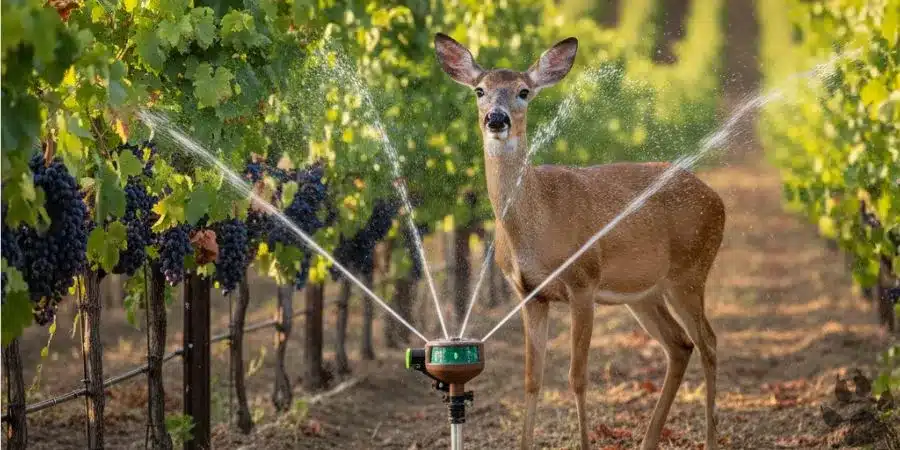
Hang bars of soap
One cheap and simple method to keep deer (and even rabbits) away from your plants is to use bars of soap, especially Irish Spring soap (the green one, not the blue one).
Here’s how it works:
- Deer don’t like the strong smell of certain soaps, especially Irish Spring, which has a scent they find unpleasant.
- The soap also contains animal fat, which can act as a natural repellent.
- When it rains, the smell from the soap spreads to the grass and soil, creating a wider area that the deer avoid.
How to use it:
- Drill a small hole in each bar of soap, tie a string through it, and hang them about every 50 feet around the area you want to protect.
- Or, cut the soap into small pieces and scatter it around your garden or field.
This method can work for an entire season, but you may need to refresh or replace the soap occasionally to keep it effective.
Can a dog really help keep deer away from grapevines?
For smaller fields (under 80 acres), dogs can be a good solution. Dogs can chase away deer and help keep them out of the area. Active, medium-sized breeds, such as retrievers, work well.
There is no special training for dogs for this task, but not all dogs can do this job well. To do this job, it is essential that the dog is able to chase animals entering the garden and be able to stay outside in all kinds of weather.
Conclusion
Deer can be a serious threat to your grapevines, especially during the late summer and fall when grapes are most appealing.
While there are no deer-resistant grape varieties, you can successfully protect your plants with the right combination of fencing, repellents, and smart deterrent methods.
Choose the solutions that match your space, budget, and level of deer activity—and enjoy a safer grape harvest.
Also wondering about other fruits deer love? Check out our related guides:
